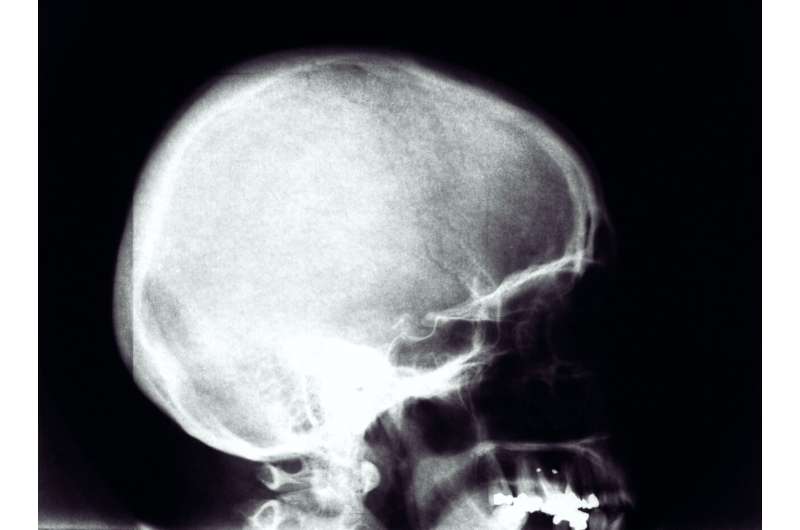International study recommends replacing skull section after treatment for a brain bleed

A major international trial has concluded that, where possible, surgeons should replace the removed section of the skull following surgery to treat a form of brain haemorrhage. This approach will save patients from having to undergo skull reconstruction further down the line.
The RESCUE-ASDH trial, funded by the UK’s National Institute for Health and Care Research (NIHR), involved 40 centres in 11 countries and involved 450 patients. The results of the trial are published today in the New England Journal of Medicine and are announced at the annual meeting of the American Association of Neurological Surgeons.
One of the potentially life-threatening results of head injury is a so-called acute subdural haematoma—a bleed that occurs between the brain and skull and can lead to the build-up of pressure. Such haemorrhages require surgery to stem the bleeding, remove the blood clot and relieve the pressure.
At present, there are two approaches to such surgery. One approach is a decompressive craniectomy, which involves leaving a section of the skull out—which can be as large as 13cm in length—in order to protect the patient from brain swelling, often seen with this type of haemorrhage. The missing skull typically will need to be reconstructed and in some treatment centres, the patient’s own bone will be replaced several months after surgery, while at other centres a manufactured plate is used.
The second approach is a craniotomy, in which the skull section is replaced after the haemorrhage has been stemmed and the blood clot removed. This approach will obviate the need for a skull reconstruction further down the line.
To date there has been little conclusive evidence and hence no uniformly accepted criteria for which approach to use. To solve this question, an international team led by researchers at the University of Cambridge and Cambridge University Hospitals NHS Foundation Trust carried out a randomised trial—RESCUE-ASDH—in which patients undergoing surgery for traumatic acute subdural haematoma were randomly assigned to undergo decompressive craniectomy or craniotomy.
A total of 228 patients were assigned to the craniotomy group and 222 to the decompressive craniectomy group. The researchers assessed the outcomes for these patients and their quality of life up to a year after surgery, as measured on clinical evaluation scales.
Patients in both groups had similar disability-related and quality-of-life outcomes at 12 months post-surgery, with a trend—which was not statistically significant—towards better outcomes with craniotomy.
Around one in four patients (25.6%) in the craniotomy group and one in five (19.9%) in the decompressive craniectomy group had a good recovery as measured on the scales.
Around one in three patients in both groups (30.2% of patients in the craniotomy group and 32.2% of those in the decompressive craniectomy group) died within the first 12 months following surgery.
14.6% of the craniotomy group and 6.9% of the decompressive craniectomy group required additional cranial surgery within two weeks after randomisation. However, this was balanced against the fact that fewer people in the craniotomy group experienced wound complications (3.9% against 12.2% of the decompressive craniectomy group).
Professor Peter Hutchinson, Professor of Neurosurgery at Cambridge and the trial’s Chief Investigator, said, “The international randomised trial RESCUE-ASDH is the first multicentre study to address a very common clinical question: which technique is optimal for removing an acute subdural haematoma—a craniotomy (putting the bone back) or a decompressive craniectomy (leaving the bone out)?
“This was a large trial and the results convincingly show that there is no statistical difference in the 12 month disability-related and quality of life outcomes between the two techniques.”
Professor Angelos Kolias, Consultant Neurosurgeon at Cambridge and the trial’s Co-chief Investigator, said, “Based on the trial findings, we recommend that after removing the blood clot, if the bone flap can be replaced without compression of the brain, surgeons should do so, rather than performing a pre-emptive decompressive craniectomy.
“This approach will save patients from having to undergo a skull reconstruction, which carries the risk of complications and additional healthcare costs, further down the line.”
The researchers point out, however, that the findings may not be relevant for resource-limited or military settings, where pre-emptive decompressive craniectomy is often used owing to the absence of advanced intensive care facilities for post-operative care.
Professor Andrew Farmer, Director of NIHR’s Health Technology Assessment (HTA) Programme, said, “The findings of this world-leading trial provide important evidence which will improve the way patients with head injuries are treated. High quality, independently funded research like this is vital in providing evidence to improve health and social care practice and treatments. Research is crucial in informing those who plan and provide care.”
More information:
Peter J. Hutchinson et al, Decompressive Craniectomy versus Craniotomy for Acute Subdural Hematoma, New England Journal of Medicine (2023). DOI: 10.1056/NEJMoa2214172
Journal information:
New England Journal of Medicine
Source: Read Full Article
